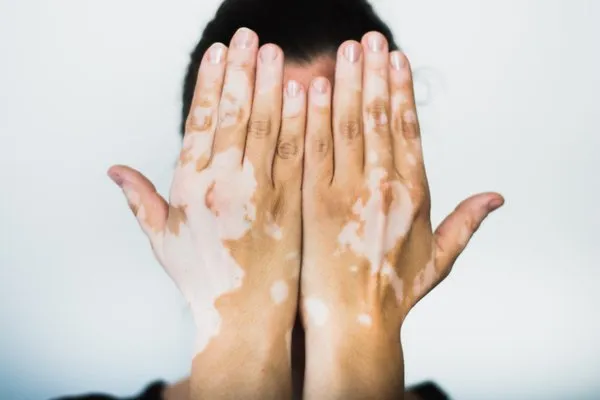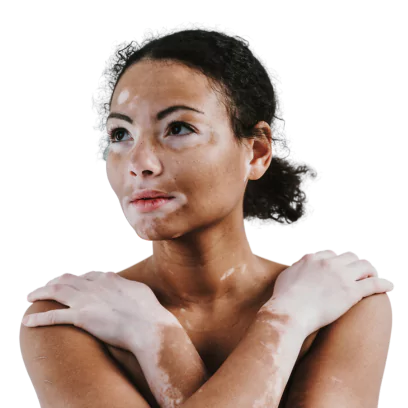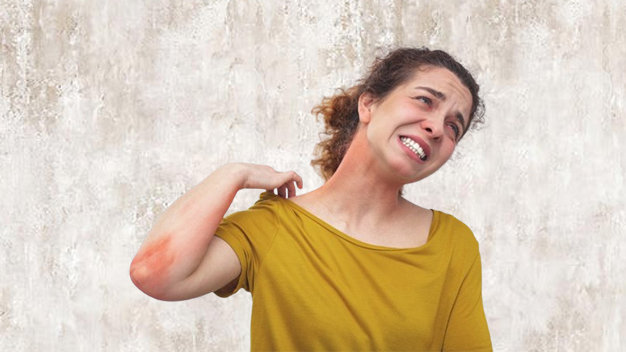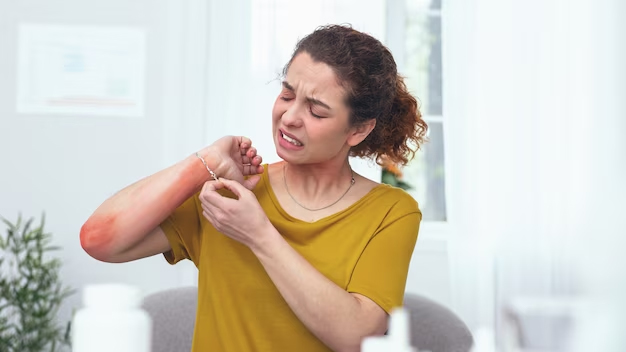On This Page
Vitiligo – Causes, Symptoms, and Ayurvedic Treatment
तव्दोतेनमण्डलमरुणंपरुषंपरिध्वंसिच।
पित्तेनपध्मपत्रप्रतीकाशंसपरिदाहंच,
श्लेष्मणाश्वेतंस्निग्धंबहलंकणडूमच्च॥ (सु.नि.५/१७) ॥
Vitiligo is an acquired skin ailment characterized clinically by totally chalk-white round or oval or elongated shaped with convex margins “macules, or “spots,” due to total absence of pigment-producing cells in the skin called melanocytes.
Melanocytes are the skin pigmentation cells, which produces melanin which gives color and protects the skin from harmful sunrays. The mechanism involves progressive destruction of selected melanocytes cells, probably by cytotoxic T-cell lymphocytes.
Ayurvedic Concepts of Vitiligo (Shwitra Kushta)
Shwitra is a disease described under the heading of Kushta by ancient Ayurveda Scholars. In Shwitra, Dhatus (Body Tissues) like Rakta (Blood), Mansa (Muscle Tissues) and Meda (Fat Tissue) are involved with Tridosha (3 Life Forces) to produce white patches or pale-yellow spots on the skin. Shwitra can be correlated with Leukoderma, which is a common skin disorder.
Shwitra is not a major disease or physical condition. Depression is often observed in these patients because of white patches on the skin. The disease also creates a disturbance to personal and social life.
Who Gets Vitiligo?
The condition is not life-threatening and non infectious. Vitiligo is a long-term disease and appears to affect at least 1% to 2% of the population, of any age (usually appears before age 30), gender or ethnic group (more noticeable in people with darker skinned).
At birth, a few cases are reported of vitiligo. Rarely there is sign of vitiligo in old age also. Over 30% of affected individuals may report a positive family inheritance.
Classification of Vitiligo
Vitiligo can be classified on clinical grounds and based on the pattern of depigmentation and is of three types:
1. Generalized Vitiligo
This is most common type, in which there is widespread distribution of white spots, often in a remarkably symmetrical array. Extensive generalized vitiligo also referred as “Vitiligo Universalis“ is complete loss of pigmentation of skin, the largest body part.
2. Focal Type Vitiligo
The focal type is characterized by one or more macules on a single site; in some cases, this may be an early evolutionary stage of one of the other forms of the disease. Typical spots occur in the fingers, elbows, knees, lower back, and genital area.
3. Segmental Vitiligo
This is an uncommon type, is characterized by one of several spots on one side of the body and the affected part of the skin area doesn’t expand with time and no new vitiligo spots appear.
Causes of Vitiligo
Both genetic (predisposing) and environmental (precipitating) factors contribute to vitiligo. Some are:-
- Autoimmune condition.
- Family history (heredity).
- A psychological factor, such as emotional stress.
- Severe sunburn may precipitate vitiligo.
- Skin trauma, such as contact with a chemical.
- People suffering from health ailments like thyroid disease and diabetes mellitus have more risk for the development of vitiligo.
Symptoms of Vitiligo
Vitiligo signs include:
- Patchy loss of skin color, which usually first appears on the hands, face, and areas around body openings and the genitals.
- Premature whitening or graying of the hair on your eyelashes, eyebrows, beard, or scalp.
- Loss of color in the tissues (mucous membranes) that line the inside of your mouth and nose.
Not All White Spots Are Vitiligo
Few health concerns are as patterned and identical as vitiligo. An accurate diagnosis of Vitiligo can be made on clinical examination and history of a patient. Woods light examination is done by a medical practitioner to examine all the spots. Sometimes the patches match on both extremities in a mirror image. Differential diagnosis is to be made with the following diseases:
- Lupus erythematosus
- Pityriasis alba
- Piebaldism
- Tinea versicolor
- Chemical leukoderma
- Post-inflammatory hypomelanosis
Ayurvedic Reference of Vitiligo (Shwitra Kushta)
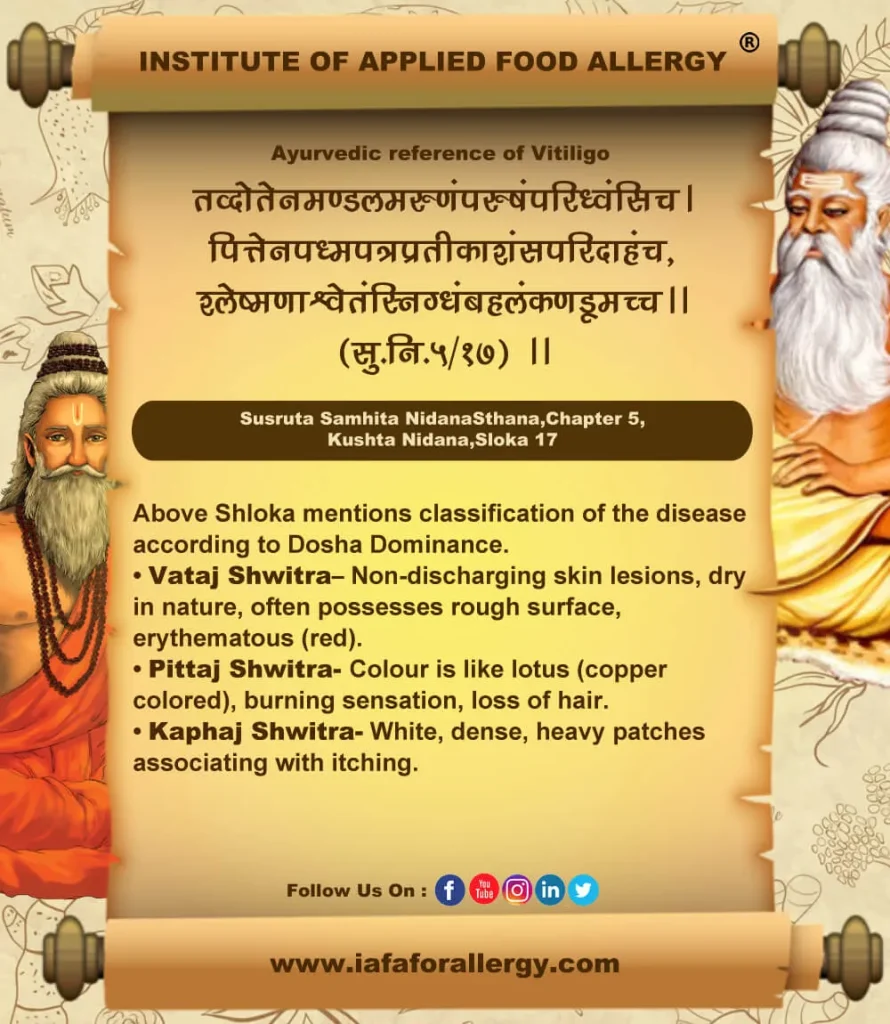
Diagnosis of Vitiligo (Shwitra Kushta) – As Per Ayurveda
In IAFA vitiligo is understood and diagnosed by Nidan Panchak.
Causes of Vitiligo (Shwitra Kushta) as per Ayurveda: Causative factor of the disease is called Nidan.
- Virudha Aahar (wrong food combinations).
- Vegvidharana (suppression of natural urges. e.g. vomiting).
- Atibhojana (consuming excess food).
- Intake of atyamala (sour), lavana (salty), madhur (sweat) and pungent food excessively.
- Intake of navinanna (heavy intake of freshly harvested grains), dahi (curd), atimansahar (excess meat-eating).
Predominant Symptoms of Vitiligo (Shwitra Kushta) as per Ayurveda: Before the disease occurs, some symptoms are developed by the body are called Poorvarupa. It can help in diagnosis.
- Excess or absence of perspiration.
- Discolored patches on the Skin.
- Itching, pricking, pain, erection of skin hair, physical exhaustion, mental fatigue.
Signs of Vitiligo (Shwitra Kushta) as per Ayurveda: Signs of the disease is called Rupa.
- Daruna – When Dosha vitiliates the Rakta Dhatu (Blood), the patches will be red in colour.
- Aruna – When Dosha vitiliates the Mansa Dhatu (Muscle Tissue), the patches will be copper in colour.
- Kilasa – When Dosha vitiliates the Meda Dhatu (Fat Tissue), the patches will be white in colour. This is the most common Rupa of Shwitra hence it is also called Kilasa.
Upshyay: To rule of disease whose manifestation don’t clear Upshyay can be used. It helps in proper diagnosis.
Stages of Formation of Vitiligo (Shwitra Kushta) as per Ayurveda: Stages of Formation of disease is known as Samprapti.
All three Doshas (Vata,Pitta,Kapha i.e. Life Forces) gets aggravated with Dhatus (Body Tissue) like Rasa, Rakta (Blood), Mansa (Muscle), Meda (Fat) and results in white patches on the skin.
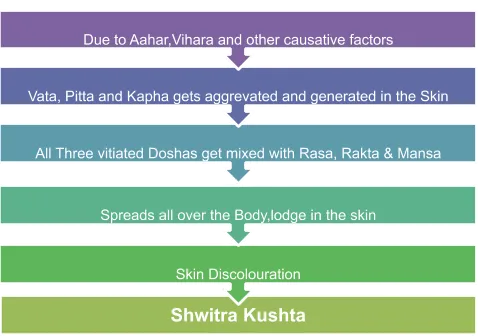

“All white patches which look like Vitiligo is a great misconception. The main aim of an intuitive practitioner is to reach the accurate diagnosis first before seeking any medical aid.”
Remarkable medicine. Remarkable care!!! Dr. Gupta’s IAFA for your healthy future!!
– Dr. Sahil Gupta (B.A.M.S., M.H.A.)
Ayurvedic Allergy Specialist
CEO & Founder of IAFA®
At last, Easier Vitiligo Management

Trusted by
More than 90,000 Patients

Convenient
at-Home Treatments

9.2 / 10
Customer Satisfaction Score
Ayurvedic Treatment for Vitiligo
In Switra roga, all three types of treatment i.e. The principle of treatment are threefold in Ayurveda as Nidana Parivarjana (removing the cause of disease), Apakarshana (Sodana therapy) and Prakriti Vighata (palliative /Samana therapy) are to be followed while treating. Selection of any of them depends upon Roga Bala, Rogi Bala, Kala, Vaya, Agni, And vyadhi Avastha etc. When the morbid Dosha are more potent, the patient should be treated with Shodhana. Long term course of treatment is needed to eliminate vitiated Dosha and brings doshas to equilibrium. The patient with Switra requires quick approach towards management, because it becomes Asadhya (difficult to treat) very quickly.
Internal Medications for Vitiligo
The following oral medications are effective in the treatment of venom allergy but should be taken under the guidance of Ayurvedic practitioner:
- Panchatiktaguggulu Ghrita
- Tiktaka Ghrita
- Mahatiktaka Ghrita
- Arogyavardhini Vati
- Krimikutara Rasa
- Bakuchi Rasayana
- Manibadragula
- Switrahara Churna
- Marichadi Taila
- Jatyadi Ghrita
- Mahamarkava Ghrita
- Mahaneela Ghrita
- Maha vajraka Ghrita
- Neelaka Ghrita
- Neeli Ghrita
- Kanakabindvarista
- Madhwasava
External Medicines for Vitiligo
- Aragwadhayadya Thaila
- Citrakadya Thaila
- Jyotishmati Thaila
- Laghu maricadya Thaila
- Maha Vajraka Thaila
- Manasiladya Thaila
- Maricadya Thaila
- Visha Thaila
Single Herbs Used in Vitiligo – As Per Ayurveda
- Bakuchi (Psoralea corylifolia)
- Maricha (Piper nigrum)
- Markava (Eclipta prostrata)
Diet Management of Vitiligo (Shwitra Kushta) – As Per Ayurveda
As per Dominance of Dosha (Life Force)
Pathya (Do’s)
- Consume old food grains, green gram, laghu (light food), patola (bitter gourd).
- Take 200ml lauki juice with mentha (pudina) 5 leaves, ocimum (tulsi) 2 leaves and a pinch of black pepper (kaali mirch) in the morning if possible.
- Drink water early in the morning placed in copper vessel at night.
- Drink Wheat Grass Juice If possible.
- Drink pomegranate juices if possible.
Apathya (Don’ts)
- Virudha aahar (wrong food combinations).
- Guru (heavy food), vidahi (spicy and pungent), vistambhi (food which creates constipation), kanda-moola (roots), masha (black gram).
- Amla, katu, lavana ras (avoid sour, pungent and salty food items).
- Excessive consumption of anupa mansa (aquatic animals).
- Donot take these dals- urad and kulthi.
- Seasame, jaggery (gur), fine flour (maida products).
- Vegetables like- brinjal, muli, capsicum, mushroom, ladyfinger, lemon, tomato and garlic.
- Dahi and dairy products/milk preparation including sweets that includes milk.
- Use black pepper instead of red chillies.
- Avoid fast and junk food completely.
- Green tea if possible avoids coffee and chemically prepared teas.
- Avoid fruits like oranges, melons, pears, blueberries, guava prunes and grapes.
- Avoid nut like cashew, almonds, pistachio and peanuts.
Lifestyle Improvement In Vitiligo (Shwitra Kushta) – As Per Ayurveda
- Avoid daytime sleep after lunch.
- Use chemical-free products for the skin.
- Regular meditation, exercise, and yoga.
- Avoid late-night awakenings.
- Protect skin from harmful UV sun rays.
Yoga And Asanas In Vitiligo (Shwitra Kushta)
Yoga detoxifies mind, soul and the body.
- Nadishodhana Pranayama
- Bhramari Pranayama
- Sitkari Pranayama
- Kapalbhati
- Shavasana
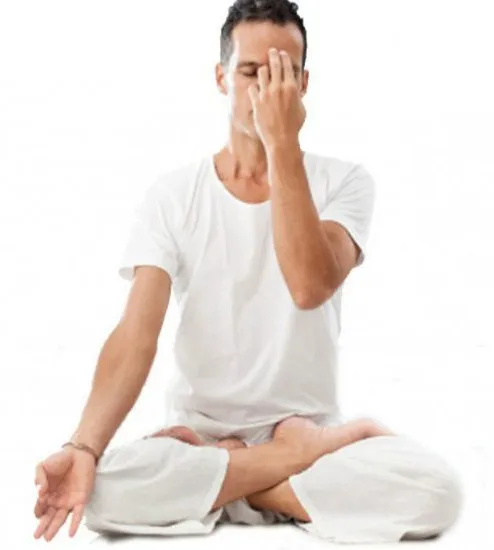
Frequently Asked Questions
Question: Can Ayurveda cure vitiligo?
Answer: Frankly, vitiligo is not high on the Ayurveda list. Ancient people have used herbs and natural remedies to treat chronic, metabolic, and stress-related conditions in past centuries. The primary principle is disease prevention and promoting longevity. Traditional treatment for vitiligo in India begins with calming the imbalanced doshas (body energies) and restoring digestion.
Question: How long it will take to treat vitiligo from ayurveda?
Answer: Treatment prognosis will vary from person to person and type of vitiligo. The Thumb rule is that you will need to follow up at least 4 to 6 months continuously before you begin to see the first positive pigmentation from IAFA treatment, and you may expect satisfactory results within 12-18 months.
Question: What necessary investigations are in vitiligo?
Answer: Vitiligo diagnosis is confirmed by physical examination methods like skin analysis underwoods lamp. But to rule out some associated health disorders and nutritional deficiency is also beneficial in result-oriented medical treatment. These are:
- Autoantibodies to be ruled out [Anti-nuclear antibody (ANA), Anti-Thyroid Peroxidase Antibody (ATPO), Anti Parietal Gastric Cell Antibody (APGC), Anti-Thyroglobulin Antibody (ATG)]
- Basal Glycaemia level may be Elevated.
- Vitamin B12 serum levels may be decreased in vitiligo patients.
- Folic Acid serum levels may be decreased in vitiligo patients.
- Thyroid Function may be disturbed.
Question: Is vitiligo curable at early stages?
Answer: Early disease manifestation is always helpful before extensive tissue and organ damage has occurred. Treatment might stop or slow the discoloring process. Vitiligo is curable when:
- The hair color on the patches is not white
- The patches are in less number
- The patches are not interlinked with each other
- The patches have recently occurred
Question: What are the side effects of oral and topical steroids in vitiligo?
Answer: long term steroids can suppress the immune system and reduce the signs and symptoms of many conditions. But these drugs also carry a risk of serious side effects. Side effects of oral steroids:
Side Effects of Topical Steroids:
Question: Does Leukoderma shorten your life?
Answer: No. Leukoderma is not a major life-threatening condition.
Question: Is there is any difference between Vitiligo and Leukoderma?
Answer: Vitiligo and leucoderma are both characterized by white patches over the skin. Although both vitiligo and leucoderma have different onset, the line of treatment for both remains the same. Due to similar characteristics and treatment plans leucoderma is a form of vitiligo.
Question: Shall I take vitamin D for my vitiligo?
Answer: Consuming 1,000–4,000 IU (25–100 mcg) of vitamin D3 daily in the prevention of different inflammatory and chronic diseases like vitiligo is generally recommended so that people with vitiligo keep their vitamin D levels in the mid-upper range of normal.
At Dr. Gupta’s IAFA offers quality and affordable medical care purely based on authentic Ayurvedic principles. IAFA ensures that our health care system better meets your health concerns.
Are you healthy and happy? If not, Think about Dr.Gupta’s IAFA for all your health-related issues.
Was this Page Helpful?
So IAFA Root-Cause Treatment of Your Vitiligo is Just 3 Steps Away!

01. Connect With Us
Share your history of illness or Book your appointment

02. Consult With Us
Dr. Gupta a certified Ayurvedic Allergist Consultant

03. Root Cause Treatment
Get an accurate diagnosis, medicines, diet & lifestyle change
Vitiligo – Case Studies
Real Case Studies of Successfully Treated Patients from All Around the World by IAFA Ayurveda®
-
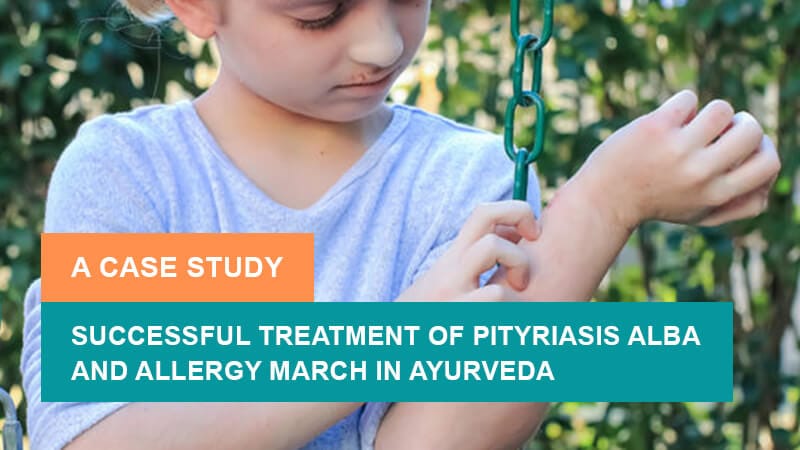
Successful Treatment of Pityriasis Alba and Allergy March in Ayurveda – A Case Study
It is a case study about successful treatment of Pityriasis Alba and…
-

Successful Treatment of Gallstones (Cholelithiasis) with Ayurvedic Medications – A Case Study
It is a case study about the successful treatment of Gallstones (Cholelithiasis)…
-
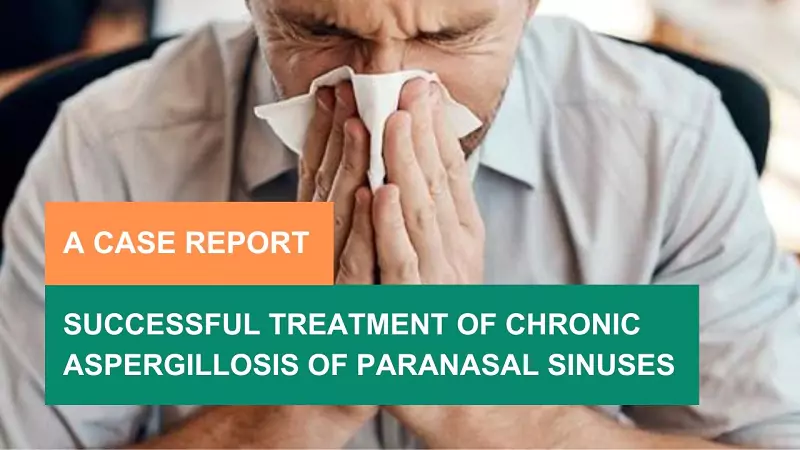
48-Year-Old Male Patient Got Relief from Chronic Aspergillosis of Paranasal Sinuses – A Case Study
Fungal infections can be treated with a high success rate by various…
-

6-Year-Old Child Patient Got Relief from Gluten Intolerance and Wheat Allergy – A Case Study
It is a case study of a 6-year-old Child Patient who got…

